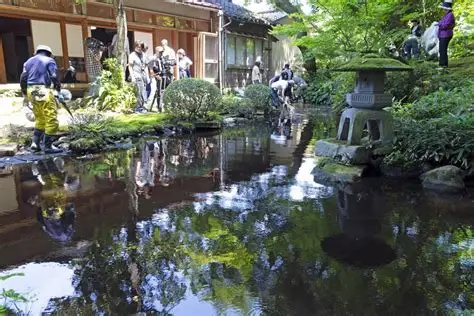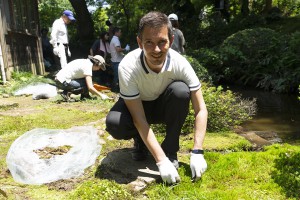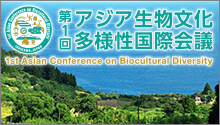On 24th June, a workshop of ‘Spiritual Road Walking and Garden Cleaning at Shinrensha Temple’ was held within Utatsuyama Temple Area in Kanazawa City, which was proposed by Dr. Juan Pastor Ivars, a research associate of the OUIK. (Hosted by: UNU-IAS OUIK, and supported by: Shinrensha Temple and Kanazawa City)
The series of workshops started last year and this sixth workshop was a big success with nearly 30 people taking part, well over the initial quota of 20 people.
There are increasing number of untended Japanese gardens
Japanese gardens can be found in urban areas and they produce biodiversity and provide numbers of ecosystem services including relaxation to the residents. This workshop is a part of a project to build a system where the Japanese gardens in Kanazawa City, which still exist in large numbers, can be maintained and managed for a long time to come. Primarily, gardens are supposed to be managed by their owners. However, due to aging of the owners, more and more gardens are becoming untended every year. Cleaning is important not only to restore the beauty of the gardens and urban landscape but also to conserve ecosystems and maintain biodiversity.
In order to conserve Japanese gardens that are designated as cultural properties by Kanazawa City, Dr. Juan holds this workshop where overseas students, foreign tourists, and local residents help cleaning the gardens and in return, they get the opportunity to attend a tea ceremony with a beautiful view of the garden or to study about gardens from various experts. In repetition, the number of participants is increasing and making a tangible impact as a new system of garden management in the city.
Precious opportunity of tending the gardens
On the day of the workshop, participants gathered at Utasu Shrine near Higashi Chaya District and walked along the Spiritual Road that winds through Utatsuyama Temple Area. As they made their way to Shinrensha Temple, they observed hollowing out of city center, i.e. vacant houses and land, and the impact of rapid tourism expansion.
The garden of Shinrensha Temple was created in early Edo period. It is a Tsukiyama Chisen-style shoin garden having a pond at the center and small artificial hills at the back. The garden also makes use of the landscape created by surrounding trees that are preserved by Kanazawa City.
First, the chief priest of the temple explained the history of the garden and a specialist of landscape architecture gave a lecture on garden management. Then, the cleaning activity started. Participants were divided into three groups to clean up different areas: artificial hills, pond, and moss area in front of the pond. Although the garden looked clean at first sight, a large amount of fallen leaves had piled up at the bottom of the pond and was turning into sludge. Taking out fallen leaves from a pond is hard work and require a lot of manpower. Young university students and overseas students showed excellent work here. Cleaning the artificial hills and the grave yard behind them was also a hard task as they were extensive. However, because we had a large number of participants this time, we divide the roles and cleaned them up quickly.
Several species of moss, such as haircap moss, grow thickly in front of the pond and show very beautiful atmosphere. However, when some parts of the moss were carefully taken off, exquisite paving stones of Tomuro-ishi appeared. In a former workshop, garden path of cobblestones called ‘ararekoboshi’ was restored in the same way. This kind of work require caution and cannot be thoughtlessly carried out without the knowledge of landscape architecture. For this workshop, we did not have to worry about this as we had several notable landscape architects. It is a valuable experience to touch Japanese gardens while learning various things from garden specialists.
After the cleaning activity, everyone relaxed with Japanese sweets and drinks gazing at the garden, experienced Japanese tea ceremony, and took a look back over the day.
Management of Japanese gardens in an enjoyable and sustainable way
Participants included students from universities within Ishikawa prefecture, overseas residents within the prefecture, and people from Kanazawa City Office. Participants had different motivation for joining the workshop. Some liked Japanese gardens, some wanted to walk the Spiritual Road, and some were moved by the sight of Dr. Juan, a Spanish man, taking care of Japanese gardens. One participant said that he got interest because he would be able to touch a precious garden. He says he feels a stronger bond with the garden after taking part in the workshop. It was also a first time for Dr. Juan to step into a garden pond this time. He says the excitement he felt at that moment is unforgettable. On the other hand, by having so many participants to a workshop like this, owners of the gardens recognize the value of their garden once again.
Dr. Juan is hoping to develop this workshop as ‘ecotourism’ in which tourists and disabled people can take part and gradually take root as a new garden management system.Being linked with SDGs goals 11 ‘Sustainable Cities and Communities’, 15 ‘Life on Land’, and 17 ‘Partnership for the Goals’, this activity will continue to be expanded as a model of sustainable cooperative management of gardens in the city.
In August, this workshop is going to be held at Honsenji Temple in Futamata-machi, Kanazawa City. Please take part in the workshop.






